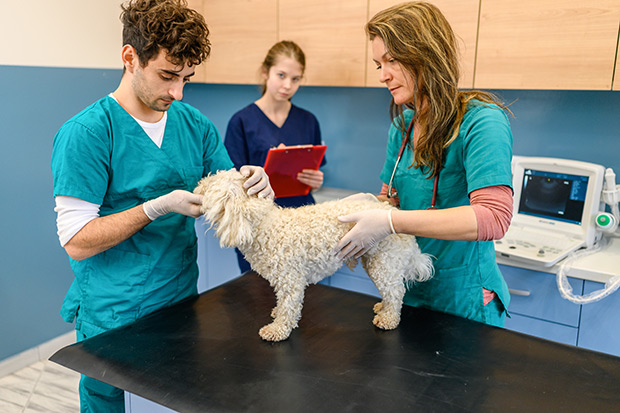Better integrating the robust veterinary technician skill set into practice
Updated April 11, 2024
Credentialed veterinary technicians (CrVTs) are versatile members of the veterinary care team, expertly tackling responsibilities in nursing, imaging, laboratory procedures, pharmacology, anesthesia, and more. In all, the entry level CrVT is required to master more than 200 tasks.
Making the most of a CrVT’s knowledge can enhance efficiency by freeing up time for veterinarians to diagnose, prescribe, and prognose.
Yet, according to the National Association of Veterinary Technicians in America’s (NAVTA) 2022 Demographic Survey, published in January 2023, the top barriers to better utilization are lack of trust and confidence by the veterinarian in the veterinary technician’s skill set, training uncredentialed staff to do CrVT tasks, and not allowing CrVTs to handle tasks that they are licensed to perform.
One in every five respondents (20%) said they do not feel fully leveraged to their fullest potential at their workplace. The same percentage of respondents said nothing is being done at their practices to attempt to improve veterinary technician utilization.
“Veterinary technicians deserve to be elevated and utilized based on their education and experience, with the understanding that with proper mentorship and support the experience portion will continue to flourish,” said Dr. Elizabeth Thompson, associate director and primary staff support to the AVMA Committee on Veterinary Technician Education and Activities (AVMA CVTEA). “It’s important for a CrVT to speak up when they have experience and qualifications to perform a skill or task.”
The veterinarian and veterinary technician should be in partnership, both supporting the other to improve patient care. The development of standard operating protocols within a practice can empower the veterinary technician while following the standard of care established by the veterinarian overseeing animal care.
“If we train tomorrow’s veterinarians to trust veterinary technicians and model the best ways the veterinary health care team works, we’ll have better teams in practice,” Dr. Thompson said.
The AVMA CVTEA’s Veterinary Technology Student Essential and Recommended Skills List is not only a resource for veterinary technology programs to use for curriculum development and an accreditation monitoring tool for the committee, but also something for practice leaders to use when onboarding veterinary technicians and undertaking role and task reviews.
The list is broken down into skills, tasks, and decision-making abilities that all CrVTs should have the prerequisite knowledge to carry out. Credentialed veterinary technicians have extensive training in the following categories:
- Office and hospital procedures, client relations, and communication
- Pharmacy and pharmacology
- Nursing
- Anesthesia
- Surgical nursing
- Laboratory procedures
- Imaging
- Laboratory animal procedures
- Avian, exotic, and small mammal procedures
Members of the public are invited to comment through April 15 on portions of the AVMA CVTEA standards that are undergoing review. In some sections, only a specific change is being presented for comment. Details are included in the commenting survey.
“Public comment helps the CVTEA to hear feedback from the workforce and meet the demands of the veterinary technician profession,” Dr. Thompson said.
Further, by referring to this list, veterinarians can feel confident in a CrVT’s abilities and design systems for effective delegation and feedback.
Creating safe spaces for communication, too, can help support and empower everyone on the team.
“Taking time to allow feedback and discussions is difficult in busy settings but can be the key to being a part of a successful team,” Dr. Thompson said. “Onboarding should be a working partnership from the start to assess and entrust clinical skills performed by the veterinary technician.”
A version of this story appears in the May 2024 print issue of JAVMA
Mat-Su College establishes Alaska’s first veterinary technology program
Matanuska-Susitna College in Anchorage, Alaska, has developed the state’s first veterinary technology program, scheduled to begin this fall.
Alaska has a shortage of veterinarians and veterinary technicians, and outside of this program, there are currently no veterinary technology or veterinary degree programs held entirely in person in Alaska.
Dr. Judith Montalbano, a professor of veterinary medicine at the college and veterinarian in the Mat-Su Valley, helped create the veterinary technology program.
The two-and-a-half-year program offers a combination of classroom and hands-on instruction including two practicums in veterinary offices, each will be 135 hours for a total of at least 270 hours.
Classes will be held at the Mat-Su College campus and associated locations such as Mat-Su Borough Animal Care and Control, the University of Alaska Fairbanks Experiment Farm, and local veterinary clinics.
Students who complete the program will earn an associate degree. The competitive program is only accepting 16 students and the application deadline was March 1.
Mat-Su College is in the process of applying for AVMA accreditation, but will not know if it meets accreditation standards until the first cohort of students are approximately two-thirds of the way through the program.
More information on the veterinary technology program can be found on the Mat-Su College website.
AVMA resources for veterinary teams
- Practice management resources: How empowering veterinary technicians supports practice success
- Continuing education webinar: How Well Do You Utilize Veterinary Technicians?
- Educational modules on diversity, equity, and inclusion: AVMA Journey for Teams
Related content
Veterinary technicians can not only survive but also thrive in profession
AAHA releases veterinary technician utilization guidelines
The backbone of veterinary technology for 50 years
Veterinary leaders concentrate on technician underutilization
Study explores secrets of highly efficient veterinary practices
Practice inefficiencies compound veterinary stress

